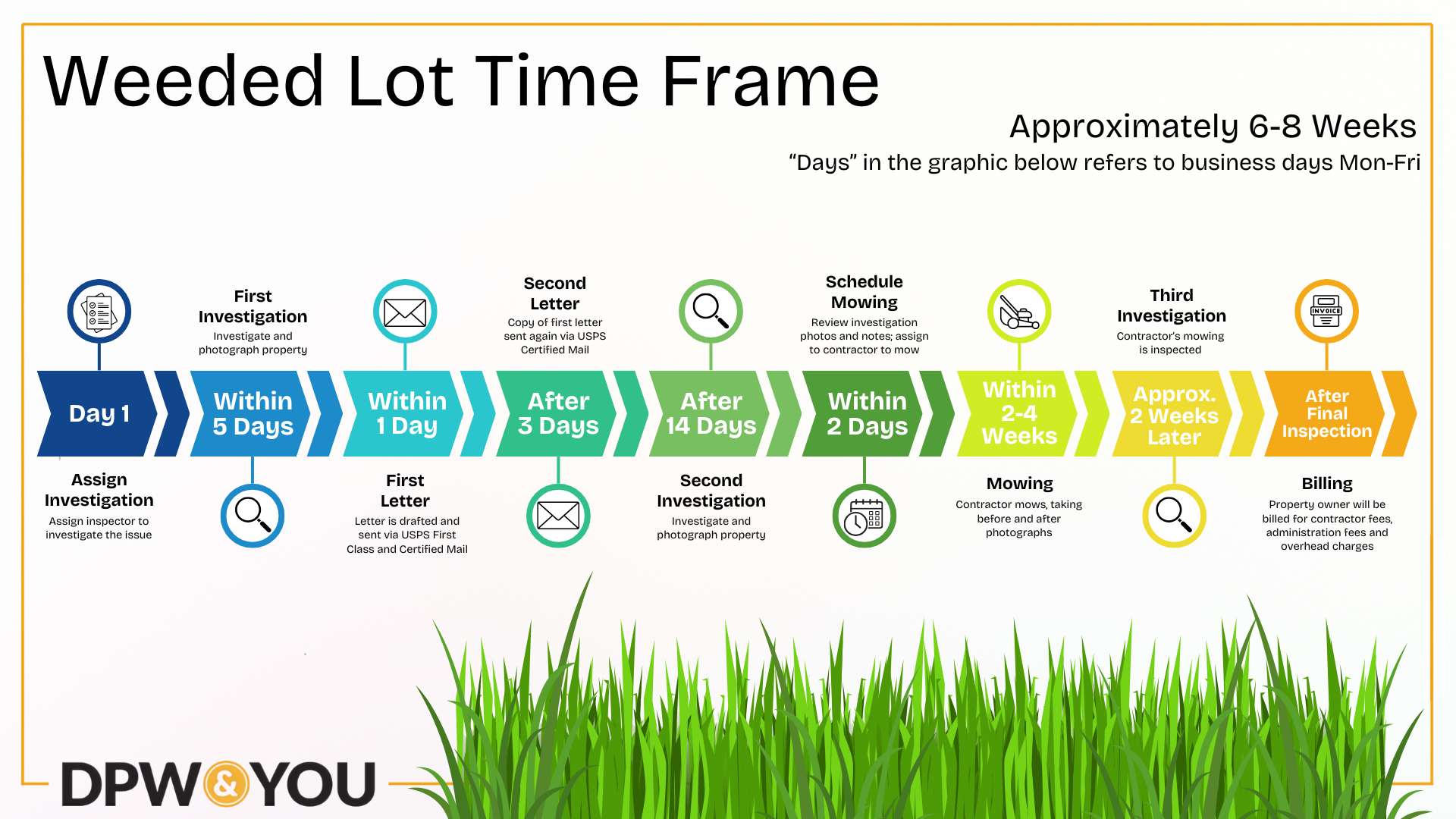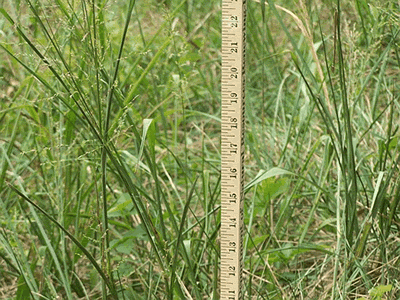
Process In Steps
-
Assign Investigation (Day 1)
Assign Inspector to Investigate
-
First Investigation (Within 5 Days)
Investigate and photograph property
-
First Letter (Within 1 Day)
-
Second Letter (After 3 Days)
Mail the same letter a second time via certified mail
-
Second Investigation (After 14 Days)
Investigate and photograph property
-
Schedule Mowing (Within 2 Days)
Review investigation photos and notes, assign contractor to mow
-
Mowing (Within 2-4 Weeks)
Contractor mows, taking before and after photographs
-
Third Investigation (Approximately 2 Weeks Later)
Inspect Contractor's mowing
-
Billing (After Final Inspection)
Once a report is received, an inspector investigates the request to verify that the property is in violation of County Code. If the property is found to be in violation of County Code, notification is sent to the property owner via a certified letter that the lot needs to be cut. In most cases, property owners resolve the violation upon notice. If the property owner does not comply, the property will be scheduled to be cut by the County's Contractor and the property owner is invoiced for all charges, including overhead.
Not paying the invoice could result in a tax lien on the property. It can cost a property owner as much as $500 each time they fail to cut their property. Additionally, this violation of the County Code carries civil penalties up to $1,000.
Report A Weeded Lot
To report a weeded lot, please call (410) 222-7321. We are available to take your call Monday through Friday from 8:00 a.m. to 4:30 p.m.
Please Note: SeeClickFix (online/mobile) requests are monitored during normal business hours, M-F 8am-4:30pm. If your request requires immediate attention and is made outside of normal business hours (or on a holiday when the County is closed), please call 410-222-8400 for assistance.
Weeded Lot FAQ's
A: BGE Utility Space, Open Space, Roadside Vegetation, Stormwater Management Ponds, RA Zoning Districts, and Unimproved lots of 3 acres or greater do not qualify.
A: Noxious Weeds - Any plant, regardless of origin, that is considered to be injurious to public health, agriculture, recreation, wildlife, or property and is designated as such by a government agency.
A: Rank Vegetation - Any growth of weeds or grass to a length of 12 inches or longer.
A: Yes. Pollinator Gardens are a great way of attracting beneficial insects, improving soil quality, and increasing biodiversity. Pollinator Gardens should be planted purposefully in a designated area with a border. This area also should be maintained and free from weeds. The suggested pollinator garden size is 12’ X 8’. It is recommended that a variety of flowering native plants be included, especially plants that provide nectar and pollen, such as sunflowers and zinnias.
Poison Ivy, Oak, and Sumac
Parasitic
- Broomrapes
- Dodders
- Varies by species (Aeginetia spp)
- Varies by species (Alectra spp.)
Terrestrial
- African boxthorn
- African couchgrass, fingergrass
- African feathergrass
- Animated oat, wild oat
- Argentine screwbean
- Arrowhead
- Asian sprangletop
- Benghal dayflower
- Bittervine
- Brazilian satintail
- British yellowhead
- Calden
- Capeweed
- Catclaw mimosa
- Cattail grass
- Coat buttons
- Cogongrass
- Common crupina
- Crofton weed
- Cusqui
- Devil’s thorn
- False caper, Geraldton carnation
- Fireweed
- Giant hogweed
- Giant sensitive plant
- Goatsrue
- Illyricum thistle
- Itchgrass
- Jointed prickly pear
- Kiawe, algarroba
- Kikuyugrass
- Kodo-millet
- Kyasumagrass
- Lightning weed
- Liverseed grass
- Maidenhair creeper
- Malabar melastome
- Mesquite
- Mile-a-minute
- Missiongrass
- Mistflower, spreading snakeroot
- Murainograss
- Old world climbing fern
- Onionweed
- Pilipiliula
- Prickly acacia
- Red rice
- Serrated tussock
- Sessile joyweed
- South African ragwort
- Stemless thistle
- Syrian mesquite
- Thin napiergrass
- Three-corned jack
- Tornillo
- Tropical soda apple
- Turkeyberry
- Velvet fingergrass, annual
- Velvet mesquite
- Virginia Creeper
- Wild blackberry
- Wild raspberry
- Wild safflower
- Wild sugarcane
- Winged false buttonweed
- Wormleaf salsola
Herbaceous Plants
- Bamboos, exotic (Bambusa, Phyllostachys and Pseudosassa)
- Canada thistle (Cirsium arvense)
- Chinese lespedeza (Lespedeza cuneata)
- Common daylily (Hemoerocallis fulva)
- Common reed (Phragmites australis)
- Garlic mustard (Alliaria petiolata)
- Giant hogweed (Heracleum mategazzianum)
- Giant reed,
- Japanese knotweed (Polygonum cuspidatum)
- Japanese stiltgrass (Microstegium vimineum)
- Lesser celandine (Ranunclulus ficaria)
- Marsh dewflower (Murdannia keisak)
- Purple loosestrife (Lythrum salicaria)
- Spotted knapweed (Centaurea biebersteinii)
- Wild cane (Arundo donax)
Vines
- Creeping euonymus (Euonymus fortunei)
- English ivy (Hedera helix)
- Five-leaved akebia (Akebia quinata)
- Japanese honeysuckle ((Lonicera japonica)
- Kudzu (Pueraria Montana v.lobata)
- Louis' swallowwort (Cynanchum louiseae)
- Mile-a-minute (Polygonum perfoliatum)
- Orienta bittersweet (Celastrus orbiculatus)
- Periwinkle (Vinca minor)
- Porcelainberry (Ampelopsis brevipedunculata)
- Wisterias, exotic (Wisteria sinensis, W.floribunda)



